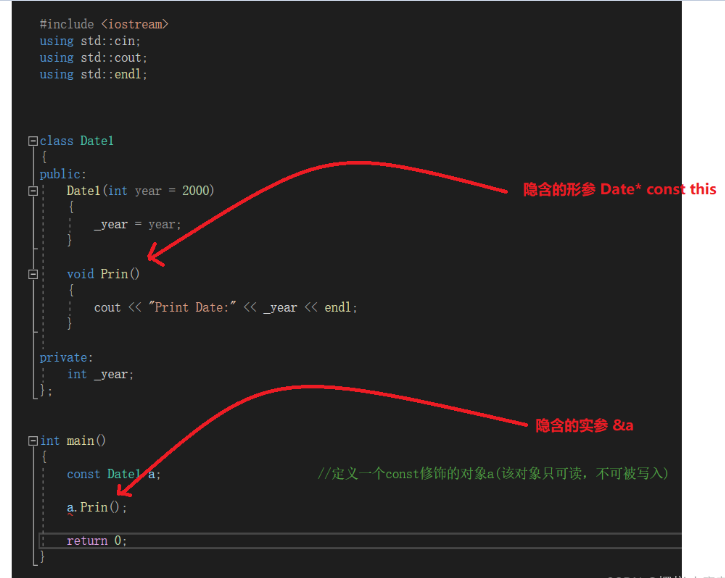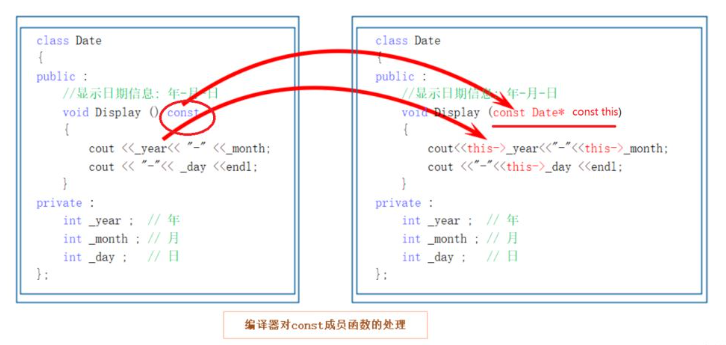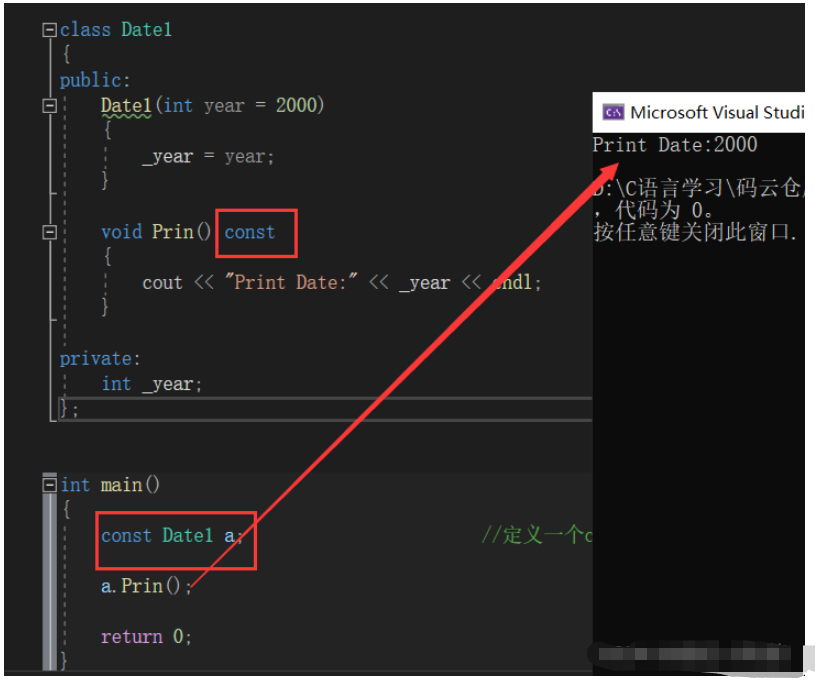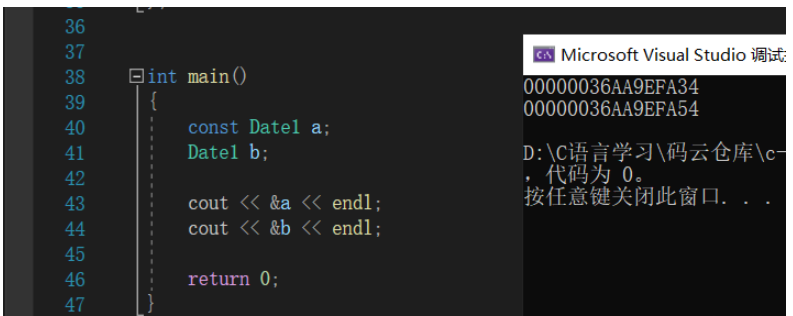C++类中const修饰的成员函数及日期类怎么使用
这篇文章主要介绍“C++类中const修饰的成员函数及日期类怎么使用”,在日常操作中,相信很多人在C++类中const修饰的成员函数及日期类怎么使用问题上存在疑惑,小编查阅了各式资料,整理出简单好用的操作方法,希望对大家解答”C++类中const修饰的成员函数及日期类怎么使用”的疑惑有所帮助!接下来,请跟着小编一起来学习吧!
一.const修饰类的成员函数
1.问题引出:
给出一段简单的代码
代码段:
#include <iostream>using std::cin;using std::cout;using std::endl; class Date1{public:Date1(int year = 2000) 类的全缺省构造函数(可无参调用){_year = year;} void Prin(){cout << "Print Date:" << _year << endl;} private:int _year;}; int main(){const Date1 a; 定义一个const修饰的对象a(该对象只可读,不可被写入)a.Prin(); return 0;}该段程序会编译报错:

2.问题分析
上述代码段出错的原因要从类的成员函数的隐含参数this指针出发进行分析:

注意:
由于a是const修饰的对象,因此&a 取出的是 const Date *类型的指针,该指针只可对a对象的内存空间进行读取操作而不可进行写入操作(该指针的权限为只可读取不可写入)。
Prin函数的形参是Date * const this指针,该类型指针同时具有读取和写入内存空间的权限。
将&a赋给Prin的形参this,就会使指针的读写权限被放大,因此编译无法通过(指针是灵活而危险的存在,编译器只允许其读写权限被缩小而不允许其权限被放大)
3.const修饰类的成员函数
我们知道类的每个成员函数都有一个隐含的this指针形参(类型为:类名*const this)。
为了使被const修饰的对象(比如是上面代码段中的a)可以调用其成员对象,C++规定可以用const来修饰类的成员函数。
类中被const修饰的“成员函数”称为const成员函数,const修饰类成员函数,本质上修饰该成员函数隐含的this指针,表明在该成员函数中不能对类的任何成员变量进行修改。(修饰后成员函数的this指针形参类型变为:const 类名* const this)
比如:


const修饰的对象不可以调用非const修饰的成员函数(类指针传参给this指针时读写权限被放大):

非const修饰的对象可以调用const修饰的成员函数(类指针传参给this指针时读写权限被缩小):

const修饰的成员函数内不可以调用其它的非const修饰的成员函数(this指针之间传参时读写权限被放大):

非const修饰的成员函数内可以调用其它的const修饰的成员函数(this指针之间传参时读写权限被缩小):

当类的成员函数中没有对类的成员变量进行任何形式的修改操作时,该成员函数最好都用const来修饰(这样安全同时又使得const修饰的对象可以调用该成员函数)以保证代码的健壮性。
二. 类的两个默认的&运算符重载

编译器会默认生成两个类的&(取地址)重载用于类的取地址操作(如果我们自定义了类的取地址重载则编译器便不会再生成默认的)
C++中,内置运算符若要直接作用于类对象则必须经过重载。
若想取到类对象的地址,我们可以对&运算符进行重载,比如:
#include <iostream>using std::cin;using std::cout;using std::endl; class Date1{public: Date1(int year = 2000){_year = year;} Date1* operator& () 对&进行重载用于非const修饰的对象的取地址{return this;} const Date1* operator&() const 对&进行重载用于const修饰的对象的取地址{return this;} private:int _year;}; int main(){const Date1 a; 定义一个const修饰的对象a(该对象只可读,不可被写入) Date1 b; cout << &a << endl;cout << &b << endl; return 0;}

这两个默认成员函数一般不用重新自定义 ,编译器默认会生成,编译其默认生成的&重载和上面我们自定义的成员函数应该没有什么区别(至少功能上没区别)。
三. 日期类小练习
日期类头文件:
为了提高代码的可维护性和可读性,将日期类的成员函数的声明和定义分开写。
#pragma once#include <iostream>using std::cout;using std::cin;using std::endl; //记录日期的类class Date {public: //Date的构造函数Date(int day=1, int month=1, int year=1);//获取月份天数的方法int GetMonthday(const int month) const;//类对象的日期打印函数void Print() const;//判断某个日期是星期几,并打印出来void GetWeekDay() const ; //一组比较运算符的重载bool operator> (const Date& date)const;bool operator==(const Date& date)const;//在逻辑上我们只需定义出大于(或小于)和等于的判断函数,剩余的判断函数我们就可以通过复用的方 式简化代码书写bool operator<(const Date& date)const;bool operator>=(const Date& date)const;bool operator<=(const Date& date)const;bool operator!=(const Date& date)const; //一组日期+(-)整数的操作和+=(-=)整数的操作Date operator+(const int day)const;Date& operator+=(const int day);Date operator-(const int day)const;Date& operator-=(const int day);Date& operator=(const Date& date);//一组前置++(--)和后置++(--)的重载Date& operator++(); //实现日期类的前置++Date operator++(int); //实现日期类的后置++Date& operator--(); //实现日期类的前置--Date operator--(int); //实现日期类的后置-- //实现时期相减的操作符重载int operator-(const Date& date)const;private:int _day;int _month;int _year; };日期类的成员函数的实现:
#include "Date.h" //Date的构造函数Date ::Date(int day, int month, int year) {_day = day;_month = month;_year = year;if (_year <= 0 || _month <= 0 || _month > 12 || _day <= 0 || _day > GetMonthday(_month)){cout << "date invalued please exit the app" << endl;exit(0);}}//获取相应月份天数的方法int Date::GetMonthday(const int month)const{static const int arr[12] = { 31,28,31,30,31,30,31,31,30,31,30,31 };int ret = arr[month - 1];if (((0 == _year % 4 && 0 != _year % 100) || (0 == _year % 400)) && 2 == month){ret++;}return ret;}//类对象的日期打印函数void Date::Print()const{cout << _year << ' ' << _month << ' ' << _day << ' ' << endl;}//判断某个日期是星期几,并打印出来//注意this指针不能由用户去传void Date::GetWeekDay()const{const char* arr[7] = { "星期一","星期二","星期三","星期四","星期五","星期六","星期日" };const Date tem(1, 1, 1900);const int subret = (*this)-tem;printf("%s\n", arr[(subret % 7)]);} //将 > 运算符进行重载bool Date ::operator> (const Date& date)const{if (_year > date._year){return true;}else if (_year == date._year && _month > date._month){return true;}else if (_year == date._year && _month == date._month && _day > date._day){return true;}return false;}//将 =运算符进行重载bool Date:: operator==(const Date& date)const{if (date._day == _day && date._month == _month && date._year == _year){return true;}return false;}//在逻辑上我们只需定义出大于(或小于)和等于的判断函数,剩余的判断函数我们就可以通过复用的方式简化代码书写bool Date :: operator>= (const Date& date)const{if ((*this) > date || (*this) == date){return true;}return false;} bool Date :: operator < (const Date& date)const{if ((*this) >= date){return false;}return true;} bool Date :: operator<=(const Date& date)const{if ((*this) > date){return false;}return true;}bool Date:: operator!= (const Date& date)const{if ((*this) == date){return false;}return true;} //一组日期+(-)整数的操作和+=(-=)整数的操作Date& Date::operator+=(const int day){if (day < 0){(*this) -= (-day);return (*this);}_day += day;while (_day > GetMonthday(_month)){if (_month < 12){_day -= GetMonthday(_month);_month++;}else{_day -= GetMonthday(_month);_year++;_month = 1;}}return (*this);}Date Date::operator+(const int day)const{Date tem(*this);tem += day;return tem;} Date& Date::operator-=(const int day){if (day < 0){(*this) += (-day);return (*this);}_day -= day;while (_day <= 0 ){if (_month > 1){_month--;_day += GetMonthday(_month);}else{_year--;_month = 12;_day += GetMonthday(_month);}}if (_year <= 0){cout << "operation invalued" << endl;exit(0);}return (*this);}Date Date::operator-(int day)const{Date tem(*this);tem -= (day);return tem;}Date& Date ::operator=(const Date& date){if (this != &date){_day = date._day;_month = date._month;_year = date._year;} return (*this);} //一组前置++(--)和后置++(--)的重载Date& Date ::operator++() //实现日期类的前置++{(*this) += 1;return (*this);}Date Date ::operator++(int) //实现日期类的后置++{Date tem(*this);(*this) += 1;return tem;}Date& Date:: operator--() //实现日期类的前置--{(*this) -= 1;return (*this);}Date Date:: operator--(int) //实现日期类的后置--{Date tem(*this);(*this) -= 1;return tem;} //实现时期相减的操作符重载int Date::operator-(const Date& date)const{int count = 0;Date min;if ((*this) < date){min = (*this);while (min != date){min++;count++;}return -count;}else{min = date;while (min != (*this)){min++;count++;}return count;}}到此,关于“C++类中const修饰的成员函数及日期类怎么使用”的学习就结束了,希望能够解决大家的疑惑。理论与实践的搭配能更好的帮助大家学习,快去试试吧!若想继续学习更多相关知识,请继续关注编程网网站,小编会继续努力为大家带来更多实用的文章!
免责声明:
① 本站未注明“稿件来源”的信息均来自网络整理。其文字、图片和音视频稿件的所属权归原作者所有。本站收集整理出于非商业性的教育和科研之目的,并不意味着本站赞同其观点或证实其内容的真实性。仅作为临时的测试数据,供内部测试之用。本站并未授权任何人以任何方式主动获取本站任何信息。
② 本站未注明“稿件来源”的临时测试数据将在测试完成后最终做删除处理。有问题或投稿请发送至: 邮箱/279061341@qq.com QQ/279061341














